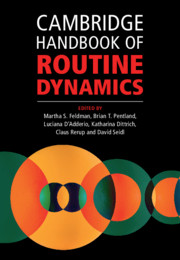Book contents
- Cambridge Handbook of Routine Dynamics
- Cambridge Handbook of Routine Dynamics
- Copyright page
- Contents
- Figures
- Tables
- Contributors
- Preface
- Chapter 1 What Is Routine Dynamics?
- Part I Theoretical Resources for Routine Dynamics Research
- Chapter 2 Practice Theory and Routine Dynamics
- Chapter 3 Process Theorizing and Routine Dynamics
- Chapter 4 Ethnomethodology and Routine Dynamics
- Chapter 5 Pragmatism and Routine Dynamics
- Chapter 6 Actor-Network Theory and Routine Dynamics
- Chapter 7 Materiality and Routine Dynamics
- Part II Methodological Issues in Routine Dynamics Research
- Part III Themes in Routine Dynamics Research
- Part IV Related Communities of Thought
- Author Index
- Subject Index
- References
Chapter 3 - Process Theorizing and Routine Dynamics
The Case for Performative Phenomenology
from Part I - Theoretical Resources for Routine Dynamics Research
Published online by Cambridge University Press: 11 December 2021
- Cambridge Handbook of Routine Dynamics
- Cambridge Handbook of Routine Dynamics
- Copyright page
- Contents
- Figures
- Tables
- Contributors
- Preface
- Chapter 1 What Is Routine Dynamics?
- Part I Theoretical Resources for Routine Dynamics Research
- Chapter 2 Practice Theory and Routine Dynamics
- Chapter 3 Process Theorizing and Routine Dynamics
- Chapter 4 Ethnomethodology and Routine Dynamics
- Chapter 5 Pragmatism and Routine Dynamics
- Chapter 6 Actor-Network Theory and Routine Dynamics
- Chapter 7 Materiality and Routine Dynamics
- Part II Methodological Issues in Routine Dynamics Research
- Part III Themes in Routine Dynamics Research
- Part IV Related Communities of Thought
- Author Index
- Subject Index
- References
Summary
In this chapter, I revisit key tenets of Routine Dynamics (RD) research to take stock of its progress and note areas for further development, and then show how strong process-cum-practice perspective, which I have called performative phenomenology, may be drawn upon to advance RD research. I argue that RD research will need to: explore how tacit knowledge affects routine enactment; better understand exogenously originated deliberate change in routines; and take explicitly on board the moral dimension of routine enactment.
- Type
- Chapter
- Information
- Cambridge Handbook of Routine Dynamics , pp. 37 - 48Publisher: Cambridge University PressPrint publication year: 2021
References
- 8
- Cited by

